The Economic Impact of a New Bucks Arena
Separating fact from fiction, what does the data show?
When it comes to sports districts, Wisconsin law makes the following assertions:
The legislature determines that a district serves a public purpose in the district’s jurisdiction by providing recreation, by encouraging economic development and tourism, by reducing unemployment and by bringing needed capital into the district’s jurisdiction for the benefit of people in the district’s jurisdiction.
A version of this paragraph–229.820(2)—appears in legislation establishing sports districts around Lambeau Field in Green Bay and Miller Park in Milwaukee. It is also included in the proposed language in Governor Scott Walker’s budget for a new Milwaukee Bucks basketball arena.
The appealing vision of economic prosperity conveyed in this statement runs counter to the consensus among sports economists who have studied the issue. Summarizing a number of studies, John Siegfried and Andrew Zimbalist reported in The Economics of Sports Facilities and Their Communities that “independent work on the economic impact of stadiums and arenas uniformly found that there is no statistically positive correlation between sports facility construction and economic development.”
In their review of the debate on the economic effects of professional sports and their role as an engine of urban economic redevelopment, Dennis Coates and Brad R. Humphreys summarize the divide between economists and advocates of public support for sports facilities and franchises:
Local political and community leaders and the owners of professional sports teams frequently claim that professional sports facilities and franchises are important engines of economic development in urban areas. These structures and teams allegedly contribute millions of dollars of net new spending annually and create hundreds of new jobs, and provide justification for hundreds of millions of dollars of public subsidies for the construction of many new professional sports facilities in the United States over the past decade. Despite these claims, economists have found no evidence of positive economic impact of professional sports teams and facilities on urban economies.
Research assessing the impact of sports franchises compares the local economic performance of areas with and without stadiums, arenas, and teams. Various models have tried to separate the effects of building new facilities or attracting or losing teams from other factors contributing to prosperity of the home cities.
Three factors are often pointed to as explanations for the lack of measurable economic effects:
- Substitution: The audience is mainly drawn from the local area. Given constraints on the entertainment budgets of consumers, spending on sports substitutes for other recreation and entertainment spending.
- Leakage: In terms of employment sports teams are actually very small businesses. Many of the athletes live outside the team’s home city, so that there is high leakage of revenues to other places.
- Impact on public budgets: Tax expenditures on sports facilities may crowd out higher priority uses, such as additional policing.
If public expenditures cannot be justified through their direct economic benefits perhaps they can be justified by making their cities more attractive places to live. Economists describe things like clean air or bike trails as “hedonic” benefits. To the extent that having a major sports team builds civic pride, its benefits may extend beyond the paying audience. In economic terms, the presence of a sports team or facility becomes “a nonexcludable public good.”
How does one measure whether a public good has made the city more attractive? Two possible indicators are rent and property values. Assuming people value something for the pleasure it brings, they should be willing to pay more to live in a city with that thing. They also should be willing to accept lower wages for the opportunity to live in a more attractive environment. By analogy, consider two cities which are identical, except for air pollution. Economists would expect pay to be lower in the city with clean air; the difference would reflect the value workers place on clean air. One reason that pay is so high in the Bakken oil fields of North Dakota is that living conditions are so miserable.
About ten years ago a study was published that aimed at quantifying the hedonic effect of sports teams. It compared cities that had gained or lost an NFL team between 1993 and 1999 to matched cities with NFL teams throughout the period. The authors concluded that within the city itself rents were 8 percednt higher in cities with a team than those without. For the entire metropolitan region, the rent differential dropped to 4%. They also found wages were 2 percent lower but the difference was not statistically significant.
A response praised the approach, but questioned the results. Among the criticisms were that the 8 percent differential seemed implausibly large, that the result was very sensitive to which cities were selected, and that the wage differential should not have been prominently displayed because it was statistically insignificant.
It is not clear, however, that this hedonic benefit is susceptible to measurement. The original estimate of an 8 percent rent increase from an NFL team does seem implausibly high. In Milwaukee, if an 8 percent rent increase were translated into property values and the tax rate was unchanged, tax collections would rise by over $200 million, enough to pay off the proposed public portion of the arena in a little over one year.
Even a 1 percent increase in property values would be enough to pay off the proposed $250 million public subsidy over a 20 year period, assuming an 8 percent interest rate. But given the many difficulties in separating out other factors and the small sample size of team or facilities that make changes, it may be impossible to detect a 1 percent change.
Perhaps the lack of published reports in the ten years since publication of study attempting to measure hedonic effects may reflect the difficulty of measuring hedonic effects. If the effect were clear, one would expect to see more reports quantifying the effect using various time periods and sports.
By contrast, a recent paper found that the Supersonics move from Seattle to Oklahoma City actually had a positive effect on property values near the Seattle arena:
After controlling for these different price dynamics, we find that the departure of the Seattle SuperSonics resulted in positive excess price appreciation for condominiums located within one mile of Key Arena. This result is robust to various measures of distance from Key Arena and impact periods over which the departure of the team might affect property values. The evidence supports the idea that the traffic, crowds, noise, trash, and other activities associated with NBA games in Key Arena represented a disamenity in the immediate neighborhood.
The results have important policy implications. Sports facilities and teams have generally been thought to generate positive amenity effects in nearby neighborhoods. Recently, TIF districts have become a popular financial mechanism for publicly funded stadium and arena construction projects. If these facilities generate important local disamenities, then TIF districts may not generate sufficient new tax revenues to pay for the facility construction, especially if the TIF district is relatively small. Also, existing local residents who live near new sports facilities may experience declines in the value of their dwellings… suggesting transfers to local residents from the owners of sports franchises are more appropriate.
Since the consensus of research is that sports teams and facilities do not alone bring significant economic development, attention has turned to their possible use as part of a broader effort, including as the core of an “arena district.” A paper on Detroit, based mostly on panels of development experts, concluded that “sport alone cannot revitalize the city, but the confluence of hospitality, mixed use planning and re-imaging of downtown areas may make an effective combination for incrementally heightening the likelihood of success.”
| Employees | |
| Retail | 594 |
| Bucks Practice Facility | 55 |
| Apartments | 36 |
| Offices | 1422 |
The Columbus Arena District is generally considered a success, particularly in attracting businesses back from the suburbs. While the arena itself (for hockey) was built with private funds, the city itself had invested approximately $36 million by 2008. The Metropolitan Milwaukee Association of Commerce, a strong supporter of the proposed Bucks arena, sponsored a paper by a Marquette finance professor. This paper estimates the employment effect of the proposed arena district in Milwaukee, as shown in the table to the right.
Most of the estimated jobs come from retail and offices, which in turn are based on projected square footage and rules of thumb for the number of employees per square foot. But the Milwaukee market for office and retail space has been weak in recent years. This could mean the arena district, rather than creating new jobs, would draw them from elsewhere in the city.
Economically, sports leagues are cartels, setting the rules to favor their members, the owners. To effectively negotiate with a cartel, one must be willing to walk away. A belief that Milwaukee cannot live without the Bucks has effectively shifted the negotiating advantage away from the taxpayers to the owners.
Historically, the big money in professional sports has been capital appreciation, the increase in value when the team is sold. Stadiums and arenas are losers, obsolete after 20 or 30 years. Any deal in which the taxpayers absorb the depreciating part without getting an interest in the appreciating part should be approached with great caution. Because of this, I would be far more comfortable with the deal if the taxpayers were given an equity position in the Bucks in exchange for their substantial financial investment in a new arena.
Note: An earlier version of the story included a study that used the wrong population and muddied the waters, and therefore was removed.
Arena Renderings
Data Wonk
-
Life Expectancy in Wisconsin vs. Other States
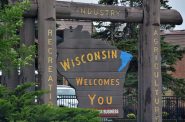 Dec 10th, 2025 by Bruce Thompson
Dec 10th, 2025 by Bruce Thompson
-
How Republicans Opened the Door To Redistricting
 Nov 26th, 2025 by Bruce Thompson
Nov 26th, 2025 by Bruce Thompson
-
The Connection Between Life Expectancy, Poverty and Partisanship
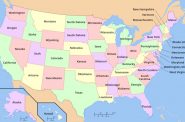 Nov 21st, 2025 by Bruce Thompson
Nov 21st, 2025 by Bruce Thompson



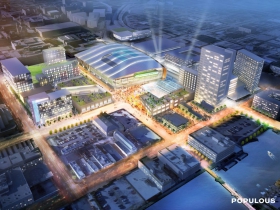
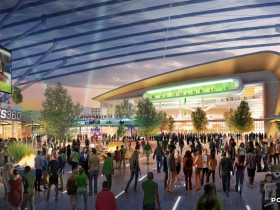
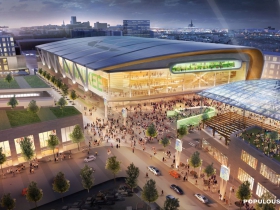




















Two thoughts.
First, it might be that statistically there are not enough stadiums, the sample may be too small compared to classes of entities economists usually study (like manufacturing and the like).
If stadiums do raise the value of the real estate around them … then why are giving the contiguous land away for 1$? Real estate markets look to the future rather than the past.
It seems the website you linked to does not have accurate data for Milwaukee/Madison. The website, http://cityobservatory.org/whos-vulnerable-to-retail-retrenchment/ links to its data source which is here: http://www.costar.com/News/Article/No-Sign-of-a-Meltdown-in-Third-Quarter-Retail-Real-Estate-Trends/106552
If you go to the costar.com website, you get the paragraph:
The 10 markets with the least shopping center space per capita include several cities with a high density of urban street retail space (not counted as shopping center space) located at the base of office or residential buildings. In order: New York City (1.66 sq. ft.), Long Island (9.3 sq. ft.), San Francisco (12.25 sq. ft.), Portland (14.43 sq. ft.), Charlotte (15.05 sq. ft.), Westchester/ So. Connecticut (15.7 sq. ft.), Milwaukee/Madison (17.59 sq. ft.), Los Angeles (17.84 sq. ft.), Providence (19.81 sq. ft.), and Northern NJ (20.2 sq. ft.).
I’m guessing there was a typo in the data spreadsheet that city observatory uses…
Great reporting/analysis, Bruce!
“The Columbus Arena District is generally considered a success, particularly in attracting businesses back from the suburbs. While the arena itself (for hockey) was built with private funds, the city itself had invested approximately $36 million by 2008.”
Wow, the Bucks cited Columbus as a model in their pitch at the County’s public hearing, not mentioning the city put up a mere $36 million. That’s about as much as City itself would hand over with its $30 parking garage to be torn down to make way for the Bucks “Live” block (bar mall). That amount is not even included in the $250M package (before interest) the Bucks are demanding (which does not include credit for any of the 25 acres they want to “master develop.” That’s another $25M at least.)
It appears the Columbus district does not have “entertainment destination” all under one roof, like Kansas City and others have done. These malls have a high failure rate, or they just struggle along. That’s even according to “destination consultant” Rob Hunden, who did a report for GMC and BID 21 recently on MKE’s entertainment needs. It appears local investors were also the driving force in Columbus, not the hockey team.
Probably the absolute last thing downtown MKE needs is an “urban entertainment destination” mall, but we might just get one ’cause the Bucks demand it and no one has the guts, as Bruce notes above, to just say no.
If people either 1) like going to Bucks games or 2) think we need the Bucks even if they are not fans, the discussion seems to end there. “Just give the team whatever they demand.”…Fantasy is more appealing than reality.
Phoenix might lose their NHL team tonight. I wonder if similar arguments are playing out in Arizona at the moment.
“In Milwaukee, if an 8 percent rent increase were translated into property values and the tax rate was unchanged, tax collections would rise by over $200 million, enough to pay off the proposed public portion of the arena in a little over one year.”
I feel like this is stated backwards. Milwaukee has an arena right now. Let it go, and you should expect rents and property value to drop 8%, leading to $200 million less in tax collections.
I agree with Kyle. The vantage point should be that there will be a decrease of 8%. Also, how many of these previous projects had a large swath of vacant land right next door? In the JS story this morning, Gary Gruneau was quoted as saying the remediation for one of the lots alone was $4 million before getting started (from his planning on the Kimpton Palomar project). The context of the land is important in regard to its worth.
If it is indeed “Cheaper to keep them” from the state perspective and that justifies their contribution then I have no problem if the project only cannibalizes from surrounding areas. Hopefully, that cannibalization comes primarily from Waukesha & Ozaukee counties. If there continues to be no regional cooperation that’s just how its gonna be. It’s not good, but that is the reality.
Weather reporting pros or cons there is many great number that can come. Fact of the matter is how will the state make up for the money the team brings in directly or indirectly? This subject has a line your for or not for the new arena. I was born and raised in Milwaukee and can say first hand this city needs the new arena. I didn’t see all this negative when the mayor said he was going to have a train downtown, which only can run a few months out of the year. Because many people like your self pick and choice what they like and don’t like. I bet you don’t like sports. The fact is your for or not for the arena and you can make the numbers say what ever you want them to either way. My opinion is any one who feels we don’t need the new arena is a uneducated dumb ass. Ya I said, it’s not the arena that brings the most return it’s the other development.
Three thoughts:
1. If stadiums generate so much ancillary development, then why in Wisconsin have we not seen this when, in the past 30 years, there have been new venues built or a venue vastly improved for all three major sports franchises? The Bradley Center is 27 years old; why didn’t massive ancillary development happen around it in the relatively strong economy of the 1990’s? Instead, as has been noted, the development occurred in many other areas of Milwaukee. Maybe people don’t actually like to live and work near massive public arenas where parking is a major hassle at least 70 nights a year and 10,000 pedestrians wander past at 10:30 pm.
2. Regarding the “Cheaper to Keep Them,” I’m guessing that the Governor and partners are not counting the fact that (if my understanding is correct) the Bucks currently keep a significant slice of the concession and other revenue generated by every other event at the Bradley Center, including concerts, Admirals, Wave and Marquette. I wonder how much concession and other revenue would remain with the BC if the Bucks were not in town to keep that cut – $5, $10, $15 million a year?
3. Also on the “Cheaper to Keep Them” track, there is no reason to think that the BC would stay completely empty on the 41-50 nights each year that the Bucks currently utilize. I would bet that the Bucks currently get first pick of dates and control scheduling of everything else. Without the Bucks, the other teams would get better scheduling to improve attendance. Concerts and other events would have more available prime dates. Sure, BC revenue wouldn’t equal what it has with the Bucks, but it would not revert back to base zero.
I like the Bucks. I watch the Bucks (on TV) and am excited about their team. I am not excited about handing money to people who don’t need it and use highly-selective numbers that are unproven and possibly erroneous to make their case.
Economic impact of NBA Sonics on Seattle:
http://www.seattletimes.com/sports/nba/sonics-argue-team-has-little-economic-impact-on-seattle/
I read somewhere that one reason more studies are not being done on sports-venue econ impact is that the evidence of so many studies was so conclusive that it’s harder to get funding for more research.
But cities/politicians keep ignoring all the studies, making up their own #s. Like “new arena will add 10,000 jobs.” Even with ancillary development, there will be 1,000 at best.
@Joe Arena aside (I’m a sports fan and want it to get done, but want a fair deal) but I just wanted to clarify some incorrect information. The streetcar will run 12 months a year, like they do in cities around the world.
Equity for taxpayers is a great idea!
Bruce and Bruce are right. development meaning more bars and restaurants are no big deal. this whole deal including the land for $1 is nuts.
Great post Bruce, very clearly written. Hopefully some people start to think differently about the arena, rather than pulling from their gut. I wanted to chime in to say that it is important for people to understand the methods of sports facility economic impact studies. Economists have pretty much closed the book on this – studies show that arenas do not provide a positive economic impact. Why, then, do we keep seeing studies that claim a new arena in [City] will have a positive economic impact?
That’s because interested parties (franchise owners, local economic development corporations, politicians, etc.) hire “economists” to do local impact studies. These studies attempt to predict the future – they are prospective – and use things like multipliers, projections, and other forms of economic guesswork. Many of the figures surrounding jobs and costs they work with are provided by franchise owners, who are certainly not a neutral party. It’s pretty much impossible to predict a city’s economic future, as there are so many things in MKE that will change over the next 30 years that nobody can foresee. Prospective studies are generally bunk.
By contrast economists who study sports facilities in an academic context use retrospective studies, which look at actual, true figures about arenas that did get built in certain cities. This, obviously, is far more reliable. Bruce does a great job of showing some heavy hitters in this field. Judith Grant Long is another important professor, from Harvard, who recently released an academic book that backs these points up. Other than that, this field is mostly dormant because the results are so conclusive – sports facilities don’t provide positive economic benefits.
I also wanted to point out that at a cost of $250,000,000 of taxpayer money (not considering interest, the lifetime cost of public services, etc.), we are subsidizing approximately 1,422 jobs, according to the prospective Marquette study. That comes out to $175,808 dollars per job. That is a disturbingly inefficient way to create jobs, especially when so many are going to be low-wage retail or service jobs. Blegh.
I gave up on any metro area economic impact studies regarding stadiums and arena’s long ago. It would be rare for one development to be so large and have such a large impact that it alone would show a statistically significant impact on a metro area. I doubt Northwestern Mutual’s tower and the new jobs would show any impact, yet that is considered a transformative development.
There are many costs and benefits though on a micro level that we can clearly see. Neighborhoods can transform and have an extensive impact on a city without showing a statiscally significant impact on the Metro area. When the third ward blossomed into it’s current state, do you think we can show that at a metro level? Doubt it. However, the benefits of that neighborhood go far beyond it’s borders as it’s plastered on just about any promotional media for the city.
There are many fiscal and intangible benefits to having an NBA team. Unfortunately when BT and Bruce Murphy analyze their own positions they only tend to look at the costs of building without really exploring the benefits. Likewise they fail to take into account the costs of losing an amenity like the Bucks.
I do not believe we should give away the farm. However, I applauded the gesture when the current and former owners offered up the $200 million. When they upped it to $250, I thought the deal was reasonable. If it holds that over runs are covered by the team owners, I am pretty comfortable with the ratio. The only matter left in my mind is who covers the rest and how.
Side bar: If Jesse’s information is correct, the retail square footage should really be corrected.
DTY, regarding your 3 points:
1. It was only in the last 10-15 years that most facilities were designed to work within neighborhoods. (I think the marquette paper even points out how this is before most of those economic impact studies were conducted) Simply, we haven’t seen activity and development around our venues because they weren’t designed to spur it.
2. The Bucks do take a large chunk of revenue from the BC, even concessions at other events. However, the revenue that the BC keeps from events generated by the Bucks outweigh how much was taken. It would be a net loss w/o the Bucks.
3. The facility is getting old (arena’s arn’t built to last that long). The old arena was not much older than the BC is now when the BC replaced it. We would still be stuck with those expenses while we get an increasingly obsolete venue. How many years can we continue to pull major concerts, etc? It will dwindle a little every year.
Thanks for highlighting the quote from the excellent 2000 review by Siegfried and Zimbalist that I presented on my poster at the June 9th hearing hosted by the county board. And thanks for highlighting the conclusions from the 2008 paper as well (that paper can be downloaded from the Huffington post we site).
I also appreciate your discussion of the fact that if we are not willing to walk away from the deal, we have lost all bargaining power. Legislation prevents municipalities from owning franchises ((the Packers were grandfathered in) so these cartels continue to extort funds from taxpayerrs to line their pockets by flattering politicians and appealing to well-connected people with high incomes who play the role of “Booster.” (One or both of these papers discussed this). All of the above have easy access to media, hence the lopsided coverage of supposed “benefits.” Don Walker told me he was sympathetic to an alternative view but had to maintain”access.” So the public hearing was a refreshing change in the conversation.
The mainstream media need to report data-driven analyses and underrepresented voices, not the drivel of those who will benefit financially if this deal goes through.
Jesse,
Good catch on the Co-Star data. There does seem to be a contradiction there. Unfortunately the person listed as a contact does not seem to work at Co-Star any more.
I finally received a copy of the spreadsheet on retail space per resident prepared by Co-Star and it is clear they entered the wrong population for Milwaukee. Correcting for that, it looks like Milwaukee falls in the middle of urban areas. Still a tough market but at least we aren’t at the extreme.
Current data on economic impact may be hard to come by, but, as noted by BT and others, respected unbiased research has repeated the same results again and again.
However, info on the Bradley Center finances is published, since they are a state-chartered entity. Here it is for 2014. Maybe BT or someone can mine it a bit to explain why the BC is so heavily in debt, after being donated.
http://bradleycenter.s3.amazonaws.com/doc/Bradley-Center-Sports-and-Entertainment-Corp-Financial-Statements-6-30-14.pdf
AG, it appears that the Bucks’ revenue share of BC income is so out of whack that the BC cannot possibly break even (about 42 percent of total product/services income). I hope we can keep the Bucks, but future deals cannot be so skewed in their favor or the taxpayers will have to also keep bailing out a new arena. It’s not being run “like a business.” No business gives away such high ratios of their income (without undue coercion). Some arenas actually do fine without a team (I hear that’s true in Kansas City). I’m not saying that would be best for MKE, but neither is it sustainable to provide massive subsidies that must be upped every generation.
Ann B., great fact-based presentation at the public hearing!
“Unfortunately when BT and Bruce Murphy analyze their own positions they only tend to look at the costs of building without really exploring the benefits. Likewise they fail to take into account the costs of losing an amenity like the Bucks.”
+1. It seems to UM that if the Bucks leave, the state and city will have 400 million dollars to spend with nothing lost by losing the bucks. If we let the Bucks leave there is a 100% guarantee that Milwaukee loses.
Thanks for the follow up Bruce, I’m still very skeptical on the county’s contributions… but it’s always good to have the correct facts during the debate. There’s nothing worse than using scare tactics divorced from reality to get your way, not saying you’re guilty of that at all, but soooo many people in this debate have made themselves look foolish doing so.
I think the economic impact is such that cities need to work with in reason to keep teams but not give away the city to keep them. Also in many municipalities IF the property value increases the tax rate is decreased automatically to keep revenue generated at the same level. This is to keep cities from artificially claiming increases in value in order to fill a budget hole.